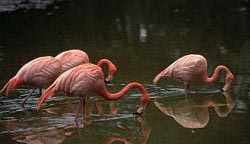
The National Symbols of The Bahamas
|
The
National Flower This flower blooms between October
and December on a tree that may grow as high as 20 feet. The evergreen
stands out because of its clusters of brilliant yellow, bell-shaped
blossoms. They are about an inch across and two inches long, with red
stripes lightly etched in the corolla. The little bells are held in a
five-point calyx, and there are nine to 13 leaflets composing the odd
pinnate leaf. Just before the blooms flare open, bag-like buds pop noisily
if squeezed.
|

|
The
National Tree
|

|
The
National Bird
|

|
The Bahamian Fish The blue marlin (Makaira
nigricans) is the majestic fish that is found in both the Atlantic and
Pacific Oceans, with reports of the largest sizes found in the latter.
However, many persons first encounter the fish in Ernest Hemingway's book
"Old Man and the Sea." Mr. Hemingway was a frequent visitor to The Bahamas,
especially the island of Bimini, where the blue marlin is highly prized
among the strong game-fishing community.
|

|
The
Bahamian Flag
|

|
The Bahamian Pledge of Allegiance I Pledge my allegiance to the
flag and to written by
Reverend Philip Rahming |
|
The National Anthem of the Bahamas
Lift up your head to the rising sun,
Bahamaland;
|
|
|
|
The Coat of Arms
The National Symbol for The Bahamas
The shield is charged with a resplendent or radiant sun to signify the world-famous balmy resort climate, and it also connotes the bright future of these islands. A flamingo, the national bird, and a silvery blue marlin support the shield. The national motto is draped across the base of the coat of arms. There was a national competition to produce the motto for the coat of arms, and the competition was won by two 11-year-old schoolchildren – Vivian F. Moultrie of Inagua Public School and Melvern B. Bowe of the Government High School in Nassau. Bahamian artist Hervis Bain prepared the preliminary design of the coat of arms.
|
